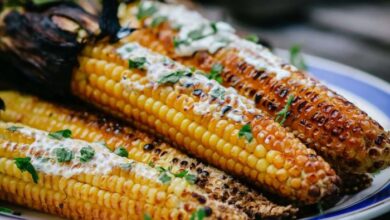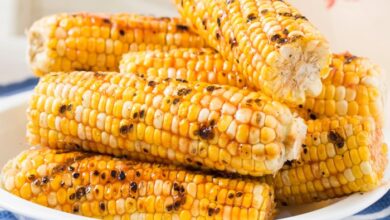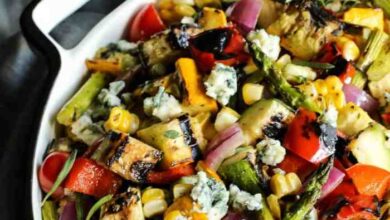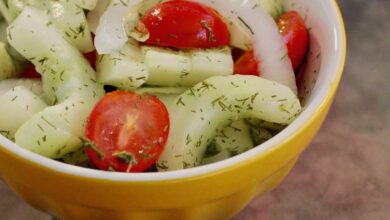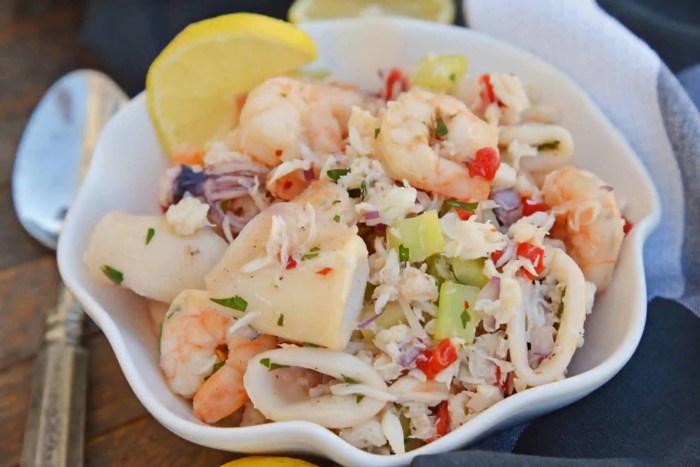
Shrimp and Crab Seafood Salad: A Culinary Adventure
Shrimp and crab seafood salad is a dish that’s as versatile as it is delicious. It’s a classic for a reason, offering a refreshing blend of textures and flavors that’s perfect for any occasion. From its humble beginnings to its modern-day variations, this seafood salad has captured the hearts (and stomachs) of food lovers around the world.
The beauty of shrimp and crab seafood salad lies in its adaptability. Whether you’re a seasoned chef or a home cook just starting out, there’s a recipe out there for you. You can customize the salad to your liking, incorporating your favorite ingredients and flavor combinations.
Seafood Salad Overview

Seafood salad, a refreshing and flavorful dish, is a popular choice for lunch, dinner, or a light snack. While its exact origins are difficult to pinpoint, the combination of seafood, vegetables, and a creamy dressing likely emerged from various culinary traditions around the world.
Popular Variations and Regional Specialties
Seafood salad has evolved into a diverse culinary landscape, with regional variations and popular interpretations showcasing the creativity of different cultures.
Shrimp and crab seafood salad is a classic dish that’s always a crowd-pleaser, especially when paired with a refreshing summer salad. If you’re looking for a heartier option, though, a creamy ham and cheese quiche like this one would be a delicious complement.
The quiche’s savory filling and flaky crust provide a wonderful contrast to the light and flavorful seafood salad, making for a well-rounded meal.
- American Seafood Salad:Often features a base of cooked shrimp, crabmeat, or a combination of both, mixed with mayonnaise, celery, onion, and sometimes hard-boiled eggs. This classic version is often served on a bed of lettuce or in a sandwich.
- Mediterranean Seafood Salad:Often incorporates ingredients like grilled octopus, calamari, and fresh herbs like dill, parsley, and oregano. Lemon juice, olive oil, and a touch of red wine vinegar contribute to the bright and tangy flavor profile.
- Asian Seafood Salad:Emphasizes the use of fresh, raw seafood like tuna, salmon, or shrimp, marinated in a soy-based dressing with sesame oil, ginger, and garlic. This style often includes a mix of colorful vegetables like cucumber, avocado, and bell peppers.
Key Ingredients and Their Roles
The success of any seafood salad lies in the careful selection and preparation of its ingredients. Each element contributes to the overall flavor, texture, and visual appeal of the dish.
- Seafood:The star of the show, the choice of seafood determines the overall flavor profile of the salad. Shrimp, crabmeat, lobster, tuna, salmon, and octopus are common choices, each bringing its own unique taste and texture.
- Vegetables:Add freshness, crunch, and color to the salad. Common vegetables include celery, onion, bell peppers, cucumber, avocado, and tomatoes.
- Dressing:Binds the ingredients together and enhances the overall flavor. Mayonnaise is a popular choice, often combined with lemon juice, vinegar, or herbs for added complexity. Other dressings, like vinaigrette or a soy-based sauce, can be used to create different flavor profiles.
Preparation and Techniques
Preparing shrimp and crab seafood salad involves a combination of seafood preparation methods and precise ingredient handling for optimal texture and flavor. The success of this dish relies on the right balance of cooked seafood, fresh vegetables, and a flavorful dressing.
Seafood Preparation Methods
The seafood used in this salad can be prepared using various methods, each affecting the texture and flavor of the final dish.
Shrimp and crab seafood salad is a classic for a reason! It’s light, refreshing, and bursting with flavor. I love to add a dollop of sweet chili thai sauce on top for a little extra kick. The sweetness of the sauce balances perfectly with the savory seafood, and the chili adds a touch of heat that’s just right.
It’s the perfect way to elevate a simple salad to something truly special.
- Steaming: Steaming seafood is a gentle cooking method that preserves its delicate flavor and moisture. It involves placing the seafood in a steamer basket over boiling water, allowing the steam to cook it evenly. Steaming is ideal for shrimp and crab as it helps retain their natural sweetness and tenderness.
- Poaching: Poaching involves gently simmering seafood in a flavorful liquid, such as broth or wine, until it is cooked through. This method is excellent for delicate seafood like crab, as it infuses the seafood with flavor while keeping it moist and tender.
- Grilling: Grilling seafood provides a smoky flavor and a slightly charred exterior. It is a great option for shrimp, which can be grilled quickly over medium heat.
Chopping and Mixing Techniques, Shrimp and crab seafood salad
Chopping and mixing ingredients correctly is crucial for achieving the desired texture and presentation of the salad.
- Uniform Chopping: Ensure all ingredients are chopped to a consistent size for optimal texture and visual appeal. For example, chop the crab meat into small, bite-sized pieces, and slice vegetables like celery and bell peppers into thin strips.
- Gentle Mixing: After chopping the ingredients, gently toss them together with the dressing to avoid breaking the seafood and vegetables. Over-mixing can lead to a mushy salad.
Dressing and Sauce Recipes
A flavorful dressing is essential for elevating the taste of the seafood salad. Here are a few dressing recipes that complement the seafood flavors:
Classic Vinaigrette
Ingredients:
- 1/4 cup extra-virgin olive oil
- 2 tablespoons red wine vinegar
- 1 teaspoon Dijon mustard
- Salt and freshly ground black pepper to taste
Instructions:
- Whisk together the olive oil, red wine vinegar, and Dijon mustard in a bowl until emulsified.
- Season with salt and pepper to taste.
Creamy Lemon Dressing
Ingredients:
- 1/2 cup mayonnaise
- 2 tablespoons lemon juice
- 1 tablespoon chopped fresh dill
- Salt and freshly ground black pepper to taste
Instructions:
- Combine the mayonnaise, lemon juice, and dill in a bowl.
- Season with salt and pepper to taste.
Spicy Mango Dressing
Ingredients:
- 1/2 cup mango puree
- 1/4 cup lime juice
- 2 tablespoons honey
- 1 teaspoon sriracha sauce
- Salt and freshly ground black pepper to taste
Instructions:
- Combine the mango puree, lime juice, honey, sriracha sauce, salt, and pepper in a blender.
- Blend until smooth.
Flavor Combinations: Shrimp And Crab Seafood Salad
Flavor combinations in seafood salad are a crucial aspect of its appeal. They can range from simple and refreshing to complex and robust, depending on the ingredients and techniques employed. By understanding the interplay of flavors, you can create a seafood salad that tantalizes the taste buds and leaves a lasting impression.
Shrimp and crab seafood salad is a classic for a reason – it’s light, refreshing, and perfect for warm weather. But sometimes you crave something hearty and flavorful, and that’s where a juicy, perfectly cooked roast comes in. For a tender and flavorful roast, check out this recipe for a high temperature eye of round roast – it’s a fantastic way to add a touch of elegance to any meal.
And, of course, a shrimp and crab salad would make a perfect side dish to this savory roast!
Flavor Profiles
Different flavor profiles can be achieved by using a variety of ingredients, each contributing its unique taste and aroma. The following table showcases some common flavor profiles and the ingredients that can be used to achieve them:
| Flavor Profile | Ingredients |
|---|---|
| Classic | Mayonnaise, lemon juice, celery, onion, black pepper |
| Mediterranean | Olive oil, red wine vinegar, capers, olives, oregano, feta cheese |
| Asian-inspired | Soy sauce, sesame oil, ginger, garlic, scallions, chili flakes |
| Tropical | Mango, pineapple, lime juice, cilantro, coconut milk |
Complementary Spices, Herbs, and Citrus Fruits
A judicious selection of spices, herbs, and citrus fruits can significantly enhance the flavor profile of your seafood salad.
- Spices:Paprika, cumin, turmeric, cayenne pepper, chili powder, black pepper, white pepper, coriander, garlic powder, onion powder.
- Herbs:Parsley, dill, chives, cilantro, basil, oregano, thyme, rosemary, tarragon, mint.
- Citrus Fruits:Lemon, lime, orange, grapefruit, tangerine.
Impact of Different Ingredients
The choice of vinegar, oil, and seasonings can have a profound impact on the overall taste of your seafood salad.
- Vinegar:Vinegar adds acidity and brightness to the salad. White wine vinegar, red wine vinegar, apple cider vinegar, and rice vinegar are popular choices, each imparting a distinct flavor profile. For a milder acidity, lemon juice can be used as a substitute.
- Oil:Oil adds richness and creaminess to the salad. Olive oil, avocado oil, grapeseed oil, and sesame oil are common choices. The type of oil used will influence the overall flavor and texture of the salad.
- Seasonings:Salt and pepper are essential seasonings that enhance the natural flavors of the seafood. Other seasonings, such as garlic powder, onion powder, paprika, and chili powder, can be added to create more complex flavor profiles.
Serving Suggestions
Shrimp and crab seafood salad is a versatile dish that can be served in many different ways. You can enjoy it as a light appetizer, a hearty main course, or a refreshing side dish. The possibilities are endless! This section will explore different serving suggestions, garnishes, and accompaniments to enhance the flavor and presentation of your seafood salad.
Serving Options
Seafood salad can be served in various ways, depending on the occasion and your preference. Here are some popular serving options:
- Individual portions: This is ideal for appetizers or a light lunch. You can serve the salad in small bowls, cups, or even lettuce cups for a more elegant presentation.
- Shared platter: For a larger gathering, you can arrange the salad on a platter, garnished with fresh herbs, vegetables, and crackers.
- Sandwich filling: This is a great way to turn your seafood salad into a quick and easy lunch or dinner. You can use crusty bread, wraps, or even croissants.
- Salad bar: Create a seafood salad bar with various toppings and sauces, allowing guests to customize their own bowls. This is a fun and interactive way to serve the salad.
Garnishes and Accompaniments
Garnishes and accompaniments can elevate the flavor and visual appeal of your seafood salad. Here are some ideas:
- Fresh herbs: Chopped dill, parsley, chives, and cilantro add a burst of freshness and flavor to the salad.
- Citrus wedges: Lemon, lime, or orange wedges provide a bright and tangy contrast to the seafood.
- Vegetables: Cherry tomatoes, sliced cucumbers, red onion, and bell peppers add texture and color to the salad.
- Toasted bread: Crusty bread, croutons, or baguette slices provide a crunchy contrast to the soft seafood.
- Seafood crackers: Serve the salad with seafood crackers for a more elegant presentation.
Accompanying Sauces
Sauces can enhance the flavor of the seafood salad and add another dimension to the dish. Here are some suggestions:
- Citrus Vinaigrette: A simple vinaigrette made with lemon juice, olive oil, and herbs is a classic accompaniment to seafood salad.
- Creamy Dill Sauce: A creamy sauce made with sour cream, mayonnaise, and dill is a delicious and tangy option.
- Spicy Remoulade: A spicy sauce made with mayonnaise, mustard, and capers adds a kick to the salad.
Presentation
Presentation is key to making your seafood salad visually appealing. Here are some tips for creating an attractive presentation:
- Use a colorful platter: A bright and vibrant platter will enhance the colors of the salad.
- Arrange the salad in layers: This creates a visually appealing presentation and allows for easy serving.
- Garnish with fresh herbs and vegetables: This adds color, texture, and flavor to the salad.
- Serve with accompanying sauces on the side: This allows guests to customize the amount of sauce they use.
Nutritional Aspects

Seafood salad is not only a delicious and refreshing dish but also a nutritious choice. It’s packed with protein, vitamins, and minerals, making it a valuable addition to a balanced diet.
Nutritional Value of Shrimp and Crab
Shrimp and crab are excellent sources of lean protein, which is essential for building and repairing tissues, as well as supporting a healthy immune system. They are also rich in various vitamins and minerals, including:
- Vitamin B12:Crucial for the formation of red blood cells and the maintenance of a healthy nervous system.
- Selenium:An antioxidant that helps protect cells from damage caused by free radicals.
- Zinc:Plays a role in immune function, wound healing, and cell growth.
- Omega-3 Fatty Acids:These healthy fats contribute to heart health, brain function, and inflammation reduction.
Comparing Seafood Types
Different types of seafood offer varying nutritional profiles. Here’s a comparison of some common options:
| Seafood | Protein (g/100g) | Omega-3 Fatty Acids (g/100g) | Vitamin B12 (mcg/100g) |
|---|---|---|---|
| Shrimp | 24 | 0.1 | 1.2 |
| Crab | 17 | 0.2 | 0.8 |
| Salmon | 20 | 2.2 | 2.5 |
| Tuna | 25 | 1.0 | 2.0 |
Incorporating Seafood Salad into a Balanced Diet
Seafood salad can be a versatile component of a healthy eating plan. Here are some tips for incorporating it into your meals:
- Serve it as a light lunch or dinner:Pair it with a side of whole grains, such as quinoa or brown rice, for a complete and satisfying meal.
- Add it to salads:Enhance the flavor and nutritional value of your salads by adding shrimp or crab.
- Use it as a topping:Sprinkle seafood salad over avocado toast or baked potatoes for a protein boost.
- Include it in wraps or sandwiches:Create delicious and nutritious wraps or sandwiches with seafood salad as the main ingredient.
Culinary Trends and Innovations
The world of seafood salad is constantly evolving, embracing new ingredients, techniques, and philosophies to create exciting and innovative dishes. From incorporating global flavors to prioritizing sustainability, chefs are pushing the boundaries of traditional seafood salad, making it more exciting and relevant than ever before.
Exotic Ingredients and Molecular Gastronomy
The use of exotic ingredients is a growing trend in seafood salad. Chefs are incorporating unique and flavorful ingredients from around the world, adding depth and complexity to their dishes. For example, the addition of ingredients like yuzu, a Japanese citrus fruit, or kimchi, a fermented Korean cabbage dish, can bring a burst of unexpected flavor to a classic seafood salad.
Molecular gastronomy techniques are also being used to create unique textures and presentations. Spherification, for example, can transform a traditional vinaigrette into tiny, flavorful spheres that burst in the mouth.
Sustainability and Ethical Sourcing
Sustainability is a crucial aspect of seafood salad preparation. Consumers are becoming increasingly aware of the environmental impact of their food choices, and chefs are responding by sourcing seafood responsibly. This means using sustainable fishing practices and choosing seafood species that are not overfished.
The use of farmed seafood, particularly when raised in a responsible manner, is also gaining popularity. The use of certified sustainable seafood, like those labeled with the Marine Stewardship Council (MSC) or Aquaculture Stewardship Council (ASC) certifications, is a growing trend.
Innovative Recipes and Presentations
Innovative recipes and presentations are elevating the classic seafood salad. Chefs are experimenting with new flavor combinations, incorporating unique ingredients, and using innovative plating techniques to create truly memorable dishes. One example is the use of edible flowers, such as nasturtiums or violas, to add a touch of color and fragrance to a seafood salad.
Another example is the use of deconstructed seafood salads, where the components are presented separately, allowing diners to create their own unique flavor combinations.

